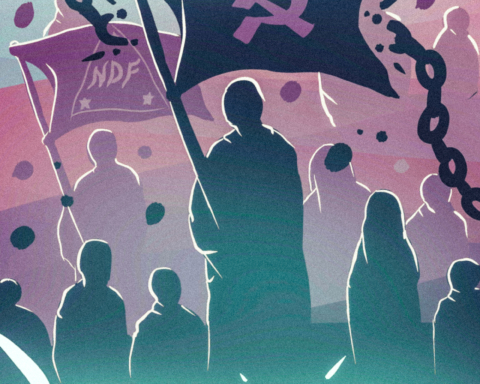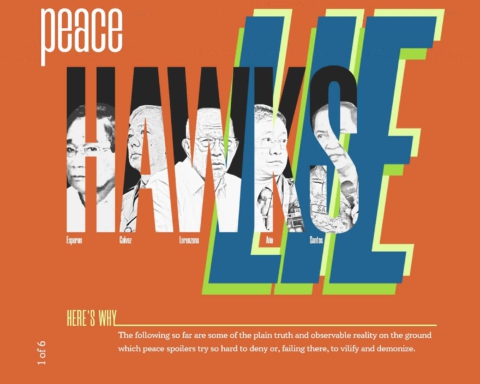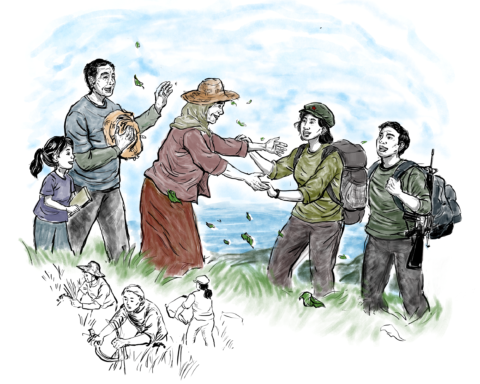
by Marie Johnson
|| Liga ng Agham para sa Bayan (LAB)-National Democratic Front of the Philippines is an organization of scientists, technologists and environmentalist for the people ||
Vinta, Yolanda, Pablo, Sendong, Quiel, Pepeng, Ondoy.
Every year, the list grows longer as the country marks another destructive typhoon that leaves widespread devastation in its wake. Every year also government authorities seem to fail to fully learn the lessons from previous disasters. They fall short of the needed preparations and respond late and inadequately to the new onslaughts. Thus, in many instances, our people in the gravely affected areas are left to face the devastations and endure the prolonged hazards and inconveniences largely on their own.
And almost always the poor and marginalized sectors—the peasants, fisherfolk, national minorities, and the urban poor and their respective communities bear the brunt of these nature-inflicted disasters.
The problem, however, is not merely government neglect or inadequate capability to cope with the disasters.
Plunder of resources = backward economy and ravaged environment
The decades-old export-oriented economic policy/program has opened the country’s natural resources to exploitation by foreign monopoly capitalists, their big comprador bourgeoisie partners and bureaucrat capitalists.
Their plunder has resulted in a ravaged environment and a backward, underdeveloped economy. The denudation of mountains and destruction of watersheds, through large-scale open-pit mining and logging operations, are primarily accountable for the ferocious flash floods, massive landslides and the incalculable devastations they entail whenever strong typhoons visit our country.
Key tools of such plunder are the neoliberal policies on mining, logging, large-scale plantations, power/energy, and other extractive and destructive industries. Of late this problem, tagged as “development aggression”, has been worsened by the militarization of vast areas of the countryside and upland communities as part of the state’s continually recycled yet unsuccessful counterinsurgency program. Not only has this development aggression been destroying the environment; it also has been displacing peasants, indigenous peoples and national minorities from their lands.
Despite our vast rich agricultural lands, forestry, marine, mineral and energy resources, the nation’s economy remains backward. It has stayed mainly agrarian and increasingly engaged in supplying cheap labor to both developed and developing economies all over the world, while exporting agricultural products and raw extractive minerals. Without a significant Filipino industrial sector, we continue to import needed industrial inputs, capital equipment, finished goods, and agricultural commodities.
National industrialization and agrarian reform keys to development and sound environment
To reduce our poor people’s vulnerability to natural disasters, we need to develop a modern and diversified industrial economy that ensures rapid and sustained growth while securing livelihood and satisfying the basic needs of our people. We need to industrialize and develop our national economy within the constraints of our fragile environment—while scientifically and conscientiously protecting, safeguarding and managing the utilization of its mineral resources and rehabilitating its damaged watersheds and enhancing its flora and fauna bounties.
This entails implementing genuine agrarian reform, rural development, and national industrialization. National industrialization seeks maximum self-sufficiency in the industrial production of both capital and consumer goods. It seeks to mobilize Filipino capital to produce primarily for domestic consumption rather than for export.
The reference book Philippine Society and Revolution highlights the stunted growth of our economy despite our vast natural resources and huge labor force. On the other hand, it also shows the enormous potential of our country to industrialize given that it is among the most mineral-rich countries in the world with many of the basic minerals needed for industrial development.
How would such industrialization look like? And what is the role of environmental protection in such a plan?
National industrialization is the development of key domestic industries to attain self-sufficiency in industrial production of capital goods needed by ancilliary industries, aimed at bringing about economic growth and independence. It also aims to develop intermediate and consumer-goods production capacity for domestic needs based on national potentials and to ensure food security and for all.
This is in contrast to the current pattern of production, investments, and trade that exports agricultural and extractive raw materials, imports surplus finished goods, agricultural commodities and capital and re-exports low value-added reassembled or repackaged imported manufactures.
A new way to look at mining and mineral processing
Mining has been part of the historical development of national economies. In the experience of industrialized nations, a prosperous mining industry is needed to supply the minerals needed for production by industries that would, along with modernized agriculture, provide the basic needs of the people.
The Philippines is a mineral resource-rich country. Despite the abundance of such resources, the country lacks the necessary industries to process the minerals. Instead, the mining sector has been liberalized further by inviting more large-scale and foreign mining corporations.
By judiciously utilizing mineral resources, we can develop a local mining industry for the production of raw materials such as base metals and basic chemicals needed by the basic heavy and medium industries producing steel for construction, engines for various uses, and agricultural tools.
Mining under a national industrialization framework departs from its current character of production, which is primarily dictated by the demands of the international market for raw minerals. Instead we shall base mineral extraction on our actual needs and the demands of industrialization. In this regard, all mining operations shall be strictly regulated to ensure the domestic processing of mineral ores up to the secondary and tertiary stages of industrial production.
We shall endeavor to build an integrated national minerals industry that would also provide employment not only on the extraction side but also in the downstream industries that should be built. These factories will process our own minerals for our own use and enable us independently to produce machinery, tools and consumers goods that we will need. It will also uncouple the mining industry from its dependence on world market prices and exports and directly integrate it to national development needs.
The country lacks intermediate processing capability for base metals since most operations directly export raw or semi-processed ores after extraction. Intermediate processing includes smelting and refining which are pre-requisites to more downstream industries, which produce the end products that factories and consumers use.
We now have smelting and refining capabilities only in gold, silver and copper but lack the necessary intermediate processing capabilities for nickel, iron and chromite which are necessary for steelmaking. Among the potential downstream industries of nickel processing are stainless steel, special steel, tool steels and batteries.
Current domestic steel consumption is approximately 7 million metric tons, with around 5 million MT imported. South Korea, now the world’s fourth largest producer of steel, started out production in 1972 by making special efforts to supply iron and steel to domestic companies at below export prices.
Mining, land reform and national industrialization
Industrial metal production should be tied with the needs of land reform and rural development. After free land distribution, agricultural modernization and mechanization would be crucial in the overall development of farm production. Agricultural mechanization pertains to the manufacture, distribution, and utilization of tools, implements, and machines for agricultural production and post-production operations.
Mechanization of farming will increase labor and land productivity. Agricultural machines and equipment help in soil preparation, better irrigation, crop protection and reduce post-harvest losses increasing effective crop yield. Currently most agricultural machinery is imported.
With an integrated minerals industry producing not only raw materials but finished metals for tools and machinery, we can reduce in steps this dependence on imports until we are self-sufficient in the production of farm machineries, tools and infrastructure materials needed by the agriculture sector.
It is not only the metals and steel industry that we should develop but also the extraction of other minerals needed by agriculture, such as fertilizers and other inputs.
Sustainability
As a general rule, since the mining industry is being developed to support and enhance our industrial capacity and to achieve food security, prime agricultural lands and areas that are targeted for food production must not be classified as mineral lands. Mining activity on such lands must be banned. Due care should also be collectively ensured so that off-site effects of mining would not adversely affect adjoining land areas.
The state has a crucial role in overseeing the disposition of our resources and industries in line with the national interest. This involves the determination of available resources; establishing sustainable targets for exploration, mine development and production; procurement and allocation of capital and technology; and management of the domestic mineral market.
The level of extraction and the amount of mineral production should be based on the desired level of industrialization and agricutural modernization. It should be done in consultation with and consent of those in mining-affected communities and should guarantee the right of indigenous peoples and national minorities to self determination and their ancestral domain.
In such mining operations, job security, living wages and safe working conditions must be ensured. Research and development for substitute and new materials, mine rehabilitation and the reduction of waste and pollution should be encouraged. At all stages of mining, environmental protection and development shall be guaranteed.
—
Note: The above discussion on mining and national industrialization has been derived from the section on environmental protection, rehabilitation and compensation of the draft Comprehensive Agreement on Social and Economic Reforms (CASER), produced by the Reciprocal Working Committee of the National Democratic Front of the Philippines peace negotiating panel for the long-running GRP-NDFP peace talks.
The draft was to have been exchanged with that of the GRP panel’s counterpart RWC and hammered out into a unified document, which was expected to be signed by the two parties in the GRP-NDFP fifth round of formal negotiations scheduled in late November last year. But President Duterte abruptly and arbitrarily cancelled the peace talks altogether.
The NDFP CASER version contains these proposals in seven sections. These are: 1) Principles of environmental protection and economic development; 2) Definition of terms; 3) Measures for managing the environment and ensuring resiliency; 4) End environmentally destructive practices; 5) Regulation of mining and marine wealth extraction; 6) Ban on alienation of natural resources and patent control; and 7) Implementing provisions.
The document recognizes that “environmental protection, conservation and wise use of natural resources are necessary components of socioeconomic development policies and that ecological balance is integral to national development”. Such economic development must make judicious use of the country’s renewable and non-renewable resources, balancing ecological concerns with economic targets and involve rational planning and zoning to alleviate congestion and pollution. It reserves the country’s lands, minerals, waters, flora and fauna, and other natural resources for utilization by the Filipino people.
The NDFP seeks to guarantee democratic consultation, consent, and participation of the affected communities in the use of our natural resources.
The proposal seeks to rehabilitate and protect watershed and other critical areas and to promote the use of renewable energy and the institution of programs to reduce waste. It also seeks compensation for people and communities affected by disasters, by massive pollution and contamination from logging, mining, energy, agro-chemical corporations, by military operations, and the like.
Moreover, the proposal prohibits ecologically destructive practices and the entry of hazardous waste and dangerous munitions.
With regard to mining, it ensures that mining shall only be undertaken when and where there are sufficient provisions for protecting and recovering the environment and that mineral production and development shall help develop local industry and modernize agriculture.
As regards our people’s vulnerability to nature-inflicted disasters, this is not only due to hydrometeorological hazards such as rainfall, typhoon winds or those from earthquakes and volcano eruptions. It is more so a function of the economic capacity of the communities exposed to these hazards. The reduction of this vulnerability will directly result from the availability of jobs that pay living wages— jobs that will result from industries that create domestic employment and serve the local market, and from agricultural modernization and land reform.









